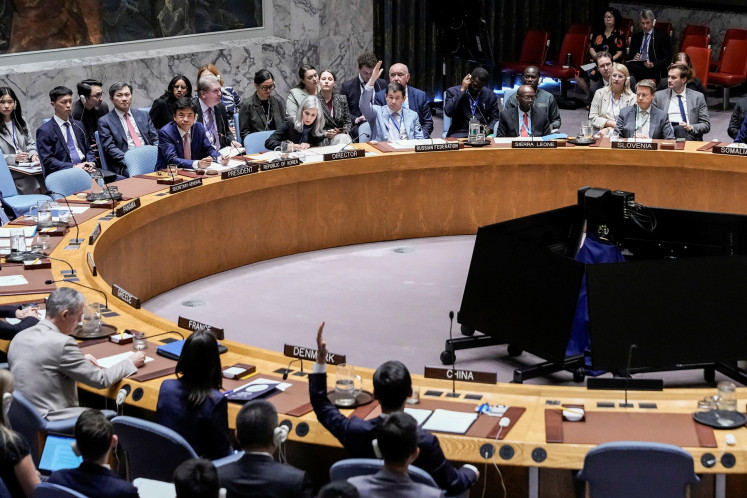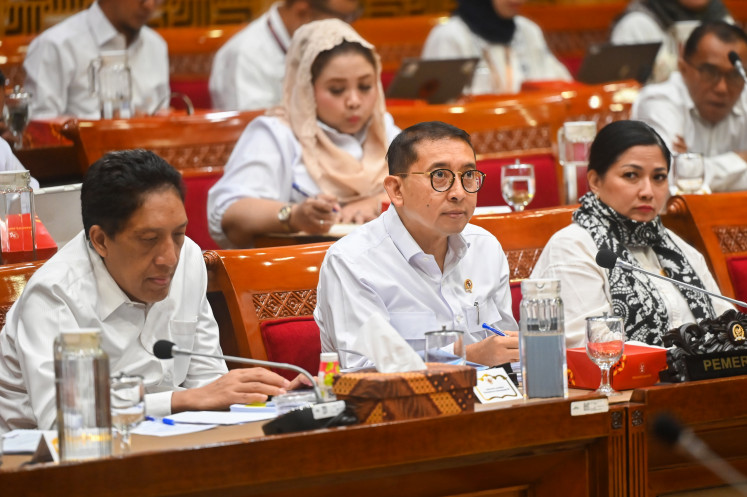Popular Reads
Top Results
Can't find what you're looking for?
View all search resultsPopular Reads
Top Results
Can't find what you're looking for?
View all search resultsBatik metamorphosis
Thousands of people thronged the main avenue, Jl
Change text size
Gift Premium Articles
to Anyone
T
housands of people thronged the main avenue, Jl. Slamet Riyadi, in Surakarta, Central Java, recently to watch the fifth Solo Batik Carnival (SBC). Solo is the cultural name of Surakarta.
The carnival began with 250 participants presenting the dance display “Batik Metamorphosis” at Sriwedari Stadium; metamorphosis being the theme of the event. As the theme implied, the show portrayed, through costumes and dance, the many phases of batik making: motif drawing on white cloth, wax treatment, coloring, wax removal and finally finishing the cloth.
Today, batik motifs are not limited to classical patterns but combine modern and traditional elements. In the carnival, the batiks on show were packed with new creations and exploration of materials, design and finished products. Contemporary designers have turned previously formal batik garments into inimitable and extraordinary designs, bestrewn with fauna and flora, real and imagined.
The carnival opened with “Ambabar Batik”, performed by members of the Solo Dance Teachers Association representing an ancient ritual by batik makers before starting their batik making process. Dozens of children in flower-shaped costumes followed, encircling almost half of Sriwedari’s soccer field at with traditional musical accompaniment.
Four groups, contributed to the metamorphosis theme: 250 models appeared one after another wearing costumes illustrating the phases of batik making.
The first group, Meta I, wore predominantly white costumes symbolizing the virgin white cambric but even these white outfits showed flowers, geese, an Apache Indian and Killer B, a character in Naruto comics.
“It took about two months to make the costumes. To reduce costs, I designed and sewed them all myself, making the total cost only Rp 1 million [US$106]. I’m very happy because the important thing is that they look great, and they do!” said delighted costume owner Ariska Zuni.
The other groups, Meta II, Meta III and Meta IV, followed elegantly into the arena to complete a spectacular show, each groups’ costumes perfectly suited to the occasion.
The show was wound up by the appearance of three Indonesian beauties: beauty queen Maria Selena (Puteri Indonesia 2011), tourism queen Andi Natassa (Puteri Indonesia Pariwisata 2011), and environment envoy Liza Elly (Duta Lingkungan 2011), who all wore batik costumes.
Sadly, the carnival at Sriwedari drew little public interest. Over half of its 6,800 seating capacity remained vacant. “We want to see an independent carnival without aid from the city budget. The ticket sales are among the paths to this end,” said Surakarta Tourism Office Head Widdi Srihanto. Tickets were available for the event in three classes: Rp. 25,000, Rp. 75,000 and Rp. 200,000.
Most people preferred to crowd the route from Jl. Slamet Riyadi to Solo City Hall, where the carnival parade passed, but lack of security allowed spectators to push their way into the middle of the street, hampering the progress of the procession. Ironically, the organizing committee was still overwhelmed by the crowds although it was the fifth time the carnival had taken place along this same route.
Jl. Slamet Riyadi, originally meant to serve as the carnival models’ catwalk, became a big public gathering place with onlookers frequently forcing carnival participants to halt and have their pictures taken.
The Solo Batik Carnival changes its theme annually. The first, in 2008 was themed Topeng (Mask), followed by Flora dan Fauna, Sekar Jagad (Flowers of the World), Keajaiban Legenda (Mystery and Legend), and in 2012 Metamorphosis. The themes have always been translated into the costumes of participants.
Since the first carnival in 2008, it has been a magnet for visitors. Carnivals in Indonesia started in Jember, East Java, with the annual Jember Fashion Carnival. With its local color, the unique fashion parade has earned Jember national fame. Organizers of the Solo carnival consulted Jember’s carnival leader, Dynand Faris.
According to Widdi, batiks have become the core of the Solo Batik Carnival. The pageant is used to popularize batik and correct the notion that batik garments are only used for formal functions.
“We want batik clothes to be worn by everybody from children to adults. They should not always be formal shirts and wraparounds, but can also be T-shirts, shorts and the like. Batiks should never be seen as something old or formal,” Widdi pointed out.
— Photos by Ganug Nugroho Adi










